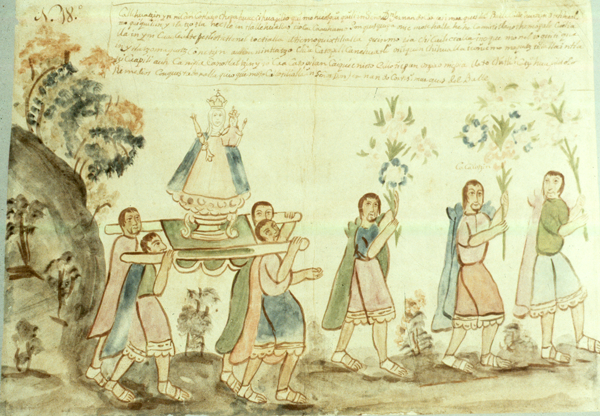full view, Scene 18
"This most pure virgin, whom you see here, is she whom Señor Don Fernando Cortes, Marquis of the Valley, brought, and who condescended to illuminate with the light of the gospel to us, who were in the darkness of idolatry: she is the same who no few times permitted herself to be seen in the air and among the clouds, and aided us when we were under necessity of fighting and converting some pueblo to the faith and when we succeeded, in thanksgiving and in order that her most holy son might bless us, believers, we carried her in public procession: then I myself formed garlands of flowers which were carried before this most holy image and to honor her I dedicated a quantity of those flowers from my lands which I hold and gave it – (the lands) – the name of Acatopilan, because these flowers I destined exclusively for this lovely virgin, called by Señor Don Fernando Cortes, Marquis of the Valley, the Conquering Virgin, the Virgin of the Remedies. (Perhaps from this time takes origin that tender devotion which the Cholultecos and many other pueblos have for the most holy Virgin of the Remedies, whom they venerate in the temple dedicated to the same most holy lady and which is located upon the top of the Pyramid of Cholula, although there is no question that it is not the conquering image brought by Hernan Cortes, because that is now in the church of Santa Clara in Puebla, as Señor Don Joaquin Albizu, who was Cura of this parish district of Cholula, Colegial antiguo of my Exmo., and Procurador of the Holy Cathedral church of the Puebla, proved clearly in his little work, written and published for that purpose.)"
[Source: Frederick Starr's English translation of the text found in the corresponding scene in the version he saw in the pueblo in 1898, published in his The Mapa de Cuauhtlantzinco (Chicago: University of Chicago Press, 1898), p. 17]
Starr's footnote: "Religious processions have been in great favor with the Indians throughout their Christian history. Notwithstanding the present laws prohibiting them, they are still common in the Indian districts of the Republic. Cacalotzin appears to be the actor." [p. 18]
